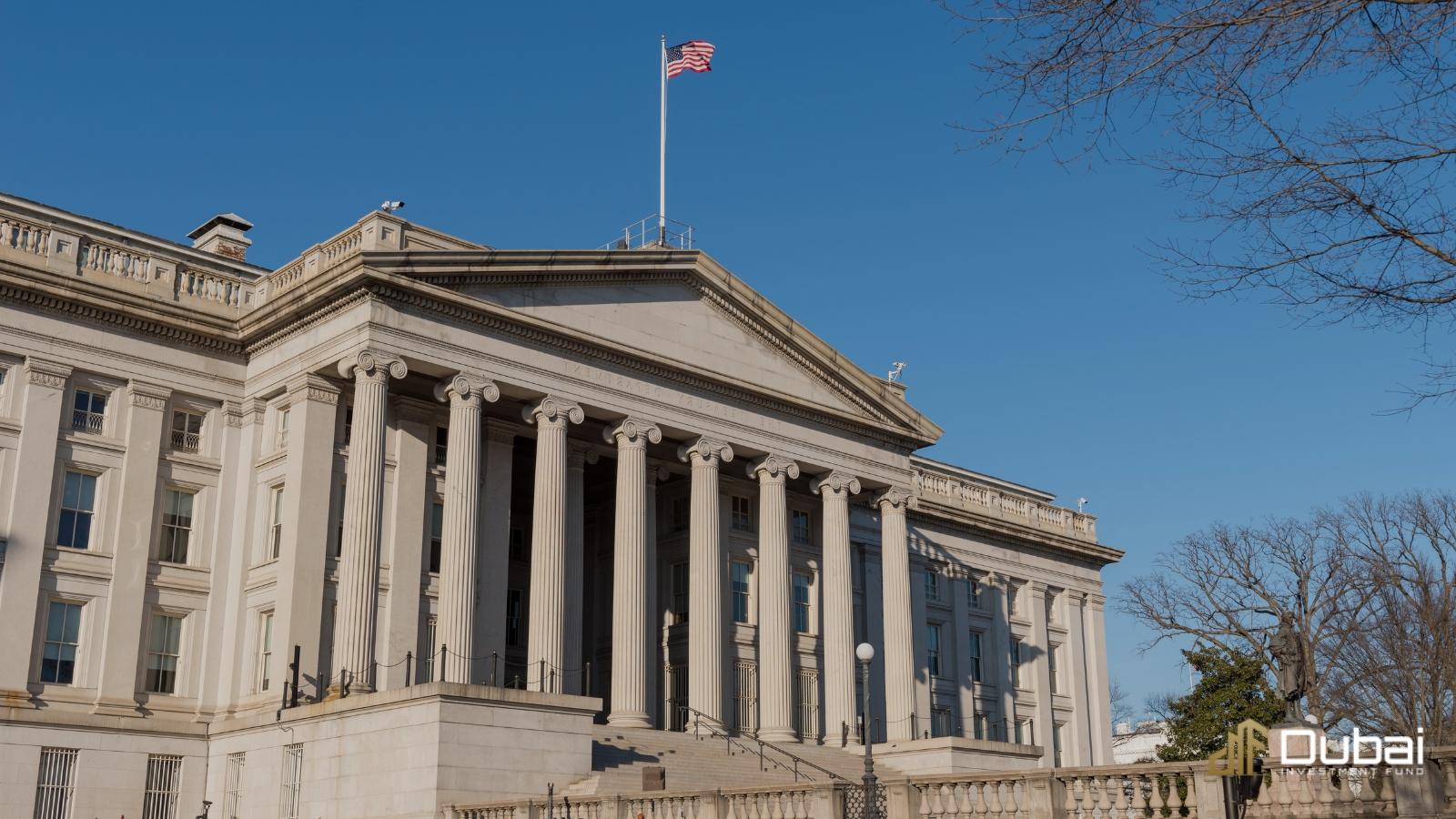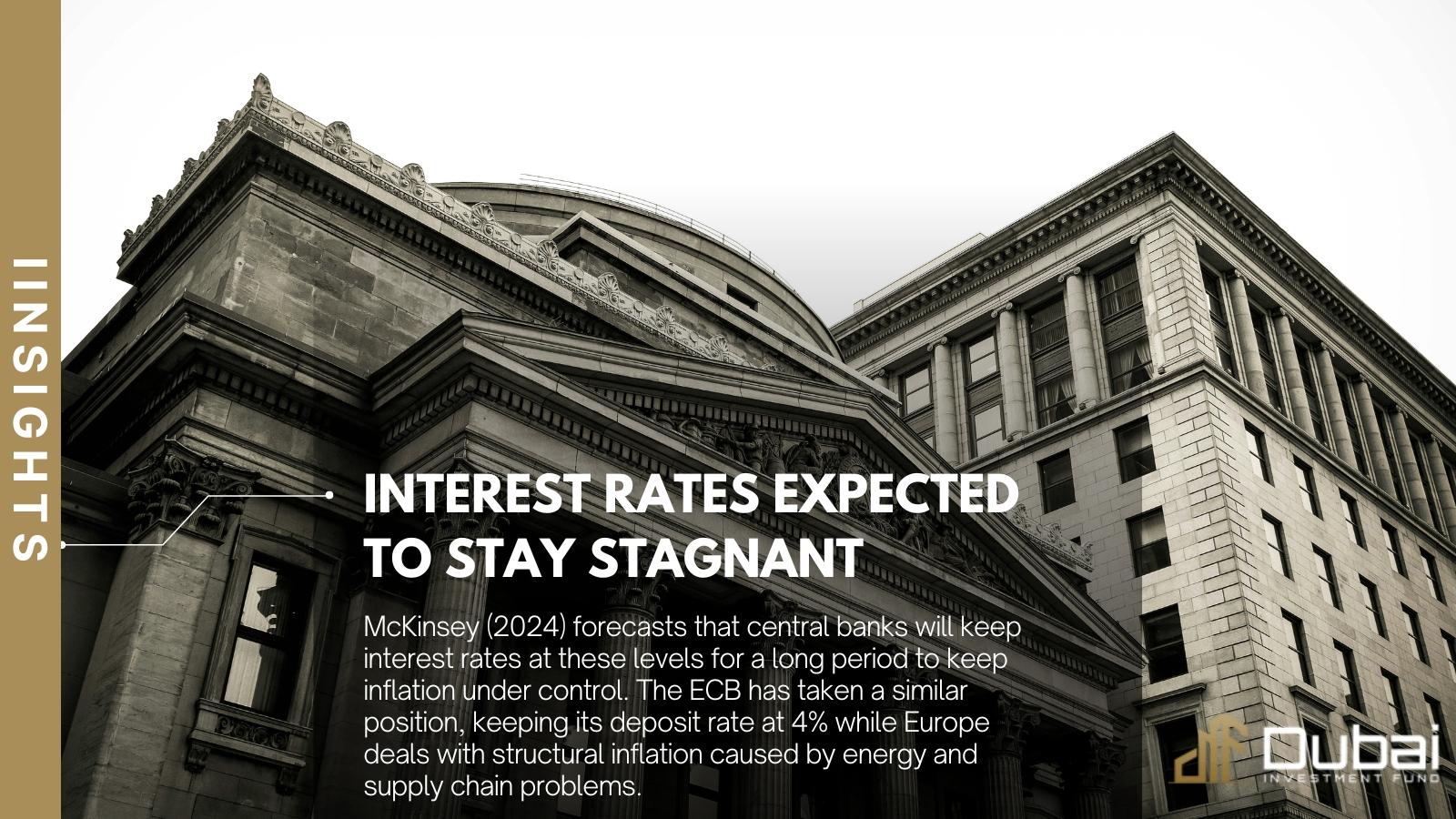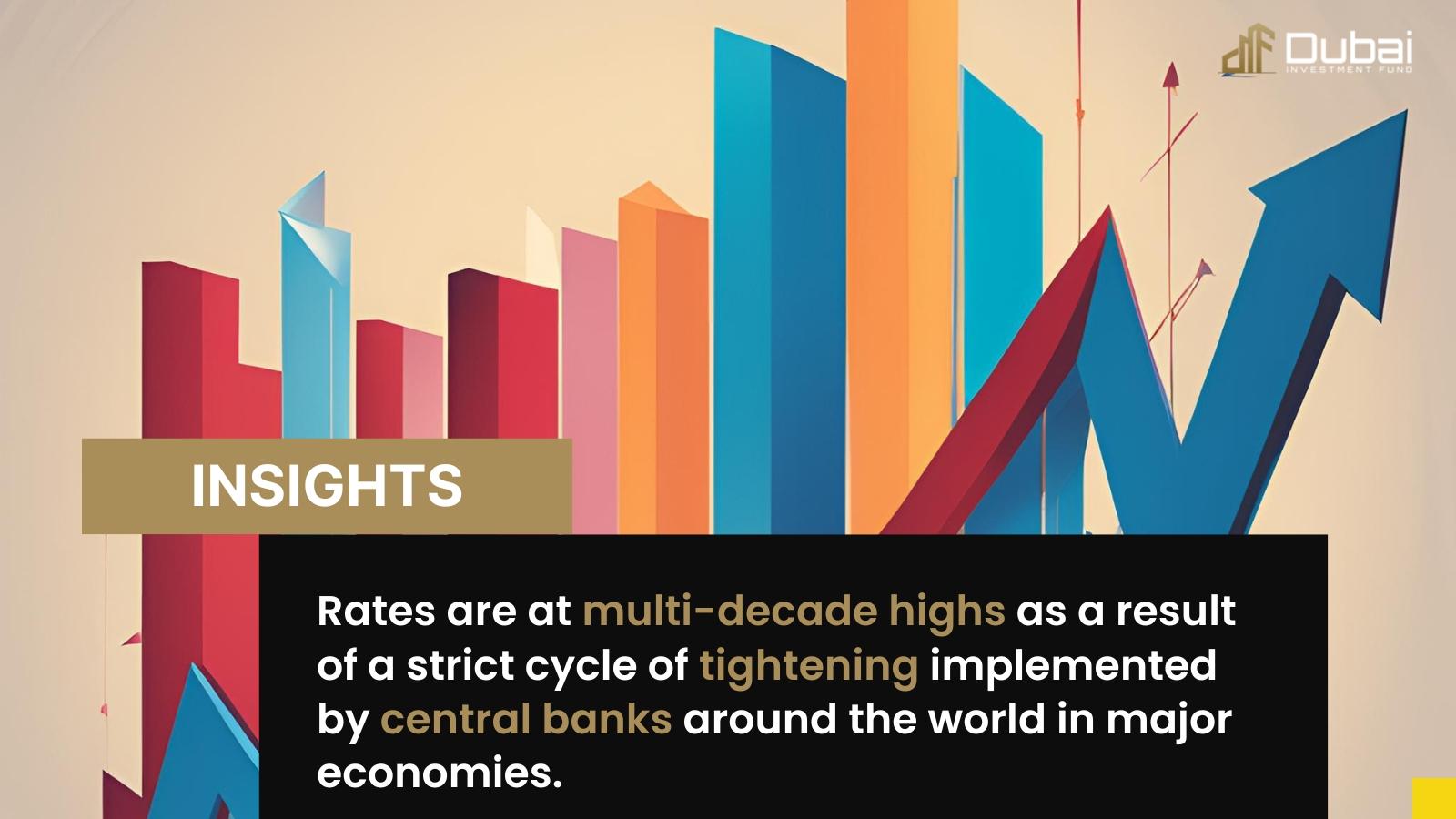Interest Rate Peaks and Plateaus: Implications for Fixed-Income and Equities
The influence of macroeconomic factors, especially the peak interest rates at a global scale, continues to be highly prevalent in the financial terrain in 2024.
Rates are at multi-decade highs as a result of a strict cycle of tightening implemented by central banks around the world in major economies. These high rates, coupled with projected stabilization, are affecting fixed-income markets and equities, obliging investors to rebalance their strategies.
This report makes use of data from top financial firms like BlackRock, McKinsey, and Bloomberg to analyze how high and steady interest rates would impact the fixed-income and stock markets.
The State of Interest Rates in 2024
Interest rates have climbed to historic highs after a series of aggressive interest rate hikes by the European Central Bank (ECB), the U.S. Federal Reserve, and many other institutions.
As an example, the Federal Reserve’s policy rate is now at its highest since 2001, between 5.25% and 5.50% (Bloomberg, 2024). Because inflationary forces have only recently started to recede, they are still above the targets set by central banks and, therefore, sustain a period of high interest rates.
McKinsey (2024) forecasts that central banks will keep interest rates at these levels for a long period to keep inflation under control. The ECB has taken a similar position, keeping its deposit rate at 4%, while Europe deals with structural inflation caused by energy and supply chain problems.
Implications for Fixed-Income Markets
Opportunities in Short-Duration Bonds
The appeal of short-term fixed-income instruments has been revived by high interest rates. With yields above 5%, Treasury bills and investment-grade corporate bonds are now a low-risk investment option (BlackRock, 2024). For example, US 2-year Treasury bonds yield 5.2%, the highest amount since 2006.
Investors have shifted capital from stocks to fixed income, with net inflows into bond ETFs exceeding $200 billion by 2023 (Bloomberg, 2024). Short-duration bonds have lower interest rate sensitivity than longer-dated assets, which is more attractive to investors.
Challenges for Long-Duration Bonds
High yields have increased the pressure on long-term bonds. The difficulties brought on by high discount rates are reflected in the 8% decrease in the Bloomberg U.S. Aggregate Bond Index over the last 12 months.
However, experts suggest that recent dips have generated opportunities for investors with longer time horizons. According to McKinsey’s 2024 report, when interest rates level or even drop in late 2025, long-term bonds might experience significant capital gains.
Corporate Debt Restructuring
Corporate balance sheets are being pressured by rising borrowing costs, especially in markets for high-yield debt. Default rates on speculative-grade bonds have climbed to 4.5%, up from 2.8% in 2022. This has resulted in increasing monitoring of credit quality and a preference for investment-grade assets.
Implications for Equity Markets
Valuation Adjustments
Higher interest rates have rebalanced equities prices, particularly in growth industries like technology. The NASDAQ Composite, which is disproportionately weighted toward growth firms, has lagged larger indices, returning a minimal 5% year to date (BlackRock, 2024).
The equity risk premium (ERP) has decreased as risk-free rates have risen, forcing investors to expect stronger profit growth to justify prices. According to McKinsey’s analysis, industries with consistent cash flows, such as utilities and consumer staples, have grown in popularity.
Sector Rotation
Growth equities are being replaced by value stocks in a high-rate environment. Financials, energy, and industrials have done well due to strong demand and increased profit margins. For example, the S&P 500 Value Index is up 12% in 2024, while the S&P 500 Growth Index is up 6% (Bloomberg, 2024).
Interest in dividend-paying equities has also risen. As Treasury rates become competitive for the income-oriented investor, corporations with large and consistent dividend payments, such as Procter & Gamble and Johnson & Johnson, have seen significant inflows of capital.
Private Markets and Alternatives
Increasing rates of discount have become a challenge for private equity and venture capital firms. Real assets, like real estate and infrastructure, are in vogue because they can hedge against inflation. The 2024 forecast by BlackRock points out the stability of private lending, which yields higher returns in the current environment.
Regional Perspectives
United States
At the center of the global interest rate narrative remains the U.S. market. However, despite its strong resilience, the global interest rate is having exporters and leveraged enterprises adversely impacted by the strong dollar and high borrowing rates.
Europe
The MSCI Europe Index is up only 3% year-to-date, which implies that European stocks have outperformed their U.S. counterparts. Defensive industries are becoming more attractive due to the ongoing volatility created by energy prices and geopolitical uncertainties (McKinsey, 2024).
Emerging Markets
Countries that export commodities, such as South Africa and Brazil, are making profits due to increased demand and good prices. Default concerns for Turkey and Argentina, which have heavy dollar-denominated debt, are on the rise (Bloomberg, 2024). Therefore, emerging markets are more of mixed signals rather than indicating one thing.
Investor Strategies for 2024
Diversification Across Asset Classes
Investors should diversify their holdings into fixed-income, stocks, and alternative investments. Dividend-paying equities and high-quality bonds could provide stability and income, while private credit and real assets offer growth opportunities.
Focus on Quality and Cash Flow
Stocks are probably going to fare better for companies that have a solid balance sheet and a predictable cash flow generator. Municipal and investment-grade bonds may offer relatively stable fixed-income solutions.
Hedging Against Inflation
Commodities, real estate investments, and inflation-linked bonds can all serve as good hedges. Inflation insurance is still necessary, according to McKinsey (2024), since future rate fluctuations are unpredictable.
Historical Comparisons: Lessons from Previous Rate Cycles
Peak interest rates in 2024 reflect comparable situations from previous decades, providing insightful information for current approaches. Historical similarities may be seen, for example, in the strong monetary tightening that took place during the early 1980s under Federal Reserve Chair Paul Volcker.
The Federal Funds Rate reached an unprecedented 20% peak at that time, which was symbolic of the extreme measures occasionally needed to counteract chronic inflation. Even while rates in 2024 are comparatively mild, the persistence of high rates shows clear similarities, indicating that longer plateaus could have a greater effect on long-term investing patterns.
Following these cycles, demand spiked for commodities and energy while industries like manufacturing and real estate faced severe challenges. Similar themes may be forming for investors now, but with the extra complexity of an economy that is internationally connected.
Sector-Specific Impacts: Beyond Traditional Narratives
Technology and Innovation
As per new trends, high-growth technology stocks are facing valuation pressure. Meanwhile, some sub-sectors like artificial intelligence (AI) and quantum computing proved themself to be more stable. This reflects that discount rate changes are less likely to impact companies with innovative, revenue-generating AI models.
While high-growth technology stocks face valuation pressure, certain sub-sectors, such as artificial intelligence (AI) and quantum computing, are proving resilient. Companies with innovative, revenue-generating AI models are less sensitive to discount rate changes, positioning them as outliers in an otherwise strained sector.
A Bloomberg report claims that investments in AI have increased by 15% annually, contrary to general trends in the IT sector.
Infrastructure and Utilities
Stable, high-rate settings continue to benefit infrastructure and utilities. Due to its consistent revenue flows and resistance to inflation, renewable energy infrastructure has seen an increase in capital allocation from sovereign wealth funds, such as the Dubai Investment Fund. Global infrastructure spending is expected to increase by 9% in 2024 (McKinsey, 2024).
Energy and Commodities
As investors seek to hedge against geopolitical risks and inflation, commodity markets are bouncing back. Valuable metals such as gold and silver have seen a 12% price gain this year due to a drop in confidence for the currencies and an increase in demand for safe-haven assets. Moreover, natural gas and oil remain the core building blocks of energy portfolios, especially with ongoing geopolitical tensions in the Middle East and Eastern Europe.
Cross-Border Capital Flows: Emerging Market Dynamics
Cross-border capital flows have been redirected towards more stable developing markets as a result of industrialized nations’ sustained high interest rates. Strong domestic development stories and a decreased reliance on debt denominated in dollars are drawing more foreign direct investment (FDI) to countries like Vietnam, Indonesia, and Kenya.
Vietnam’s industrial exports, for instance, have increased by 18% a year, taking advantage of global supply chain realignments. At the same time, Kenya has become a hub for venture capital, with inflows of over $3 billion in 2023 due to its focus on fintech and mobile banking (Bloomberg, 2024).
Geopolitical Influences on Rate Policies
Across all areas, geopolitical issues continue to influence monetary policy. Global commerce and investment are becoming more unstable due to the South China Sea tensions and the Russo-Ukrainian war. Forecasts for rate plateaus are becoming more difficult as central banks increasingly take geopolitical stability into account when determining policy.
The cautious approach taken by the European Central Bank is a reflection of its dual task of preserving monetary stability and assisting countries that are very vulnerable to fluctuations in energy prices. Asian nations, however, are taking a variety of strategies. India has implemented modest rate rises to reduce imported inflation, while Japan is steadfast in its commitment to low rates under its yield curve management strategy.
Behavioral Shifts Among Institutional Investors
Strategies for institutional investments are changing as a result of the extended high-rate situation. Barbell techniques are being used by pension funds, endowments, and sovereign wealth funds to balance short-duration, high-yielding assets with long-duration, carefully chosen assets that are likely to appreciate over time.
Furthermore, there is a resurgence of interest in real estate investment trusts (REITs) that focus on healthcare and logistics buildings. For example, strong e-commerce demand and supply chain realignments helped logistics REITs enjoy a 7% increase in total returns in 2024 (BlackRock, 2024).
Monetary Policy Divergence: Implications for Currency Markets
Currency market volatility is being fueled by big nations’ diverse monetary policies. Because of divergent policy stances, currencies such as the Chinese yuan and Japanese yen have declined, while the U.S. dollar has held steady owing to high rates. With net inflows into currency-hedged equities strategies surpassing $25 billion in the first half of 2024, these strategies have become increasingly popular (McKinsey, 2024).
Because of the ECB’s hawkish approach, the euro has performed quite steadily throughout Europe. However, higher borrowing rates for periphery economies like Greece and Italy highlight the risks of Eurozone collapse.
Emerging Themes in Fixed Income and Equities
ESG Integration in Fixed Income
Environmental, social, and governance (ESG) factors are becoming more and more popular in fixed-income markets. For example, government and business commitments to sustainability goals have led to a 20% increase in the issuance of green bonds in 2024. These tools are increasingly vital for investors looking to match long-term climate goals with their investments.
Small-Cap Equities Resilience
The Russell 2000 Index is beating the S&P 500 by 3% year-to-date, demonstrating the surprisingly strong performance of small-cap firms. This pattern is explained by strong profit growth in narrow areas that are less impacted by global macroeconomic difficulties, including specialty chemicals and renewable energy components.
Preparing for the Next Phase of the Rate Cycle
Investors are already looking forward to the next stage, which may include rate reduction in late 2025, as markets adapt to the new normal of high rates. Portfolios should be positioned to profit from this potential change by expanding their exposure to high-beta industries like technology, cyclical stocks, and long-duration bonds.
At the same time, alternative investments such as infrastructure funds and private equity are probably going to continue to be important parts of the diversified strategy. Private market players are in a good position to profit from assets that are cheap since dry powder levels are at all-time highs.
Conclusion
Investment paradigms are shifting as a result of the period of interest rate peaks and plateaus. While equities markets see sector rotations and value adjustments, fixed-income markets are experiencing an upsurge of interest. A balanced and disciplined approach can help investors overcome these obstacles and take advantage of fresh opportunities in 2024.





